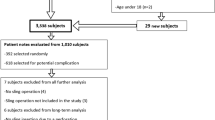Abstract
Purpose
To provide our single-center experience with an approach to refractory stress urinary incontinence (SUI) with permanent urethral ligation (PUL) and suprapubic tube (SPT) placement, in hopes of contributing to the limited body of research surrounding this surgical treatment option for patients with end-stage urethra (ESU).
Methods
All patients undergoing PUL with SPT placement from 01/01/2018 to 04/30/2022 were identified from an institutional database. Institutional Review Board exempt status was granted for the conduct of this study. Patients were seen postoperatively at 1 month and 1 year. If there were any concerns of incontinence, an antegrade urethrogram via the SPT was performed. Descriptive statistics were used to evaluate patients.
Results
Seven patients underwent PUL with SPT in our timeframe and were included in the study. All patients previously had an AUS placed, and two patients had a urethral sling previously placed. The median follow-up time was 21 months, ranging between 2 and 48 months. Complications included bladder spasms (43%) and continued leakage per urethra (14%). Of the 7 patients, 6 have reported continence through their urethra at their most recent follow-up.
Conclusion
This initial data suggest that PUL with SPT placement may be a viable surgical approach to treating refractory SUI, especially for patients with ESU who wish to avoid the morbidity associated with more formal supravesical diversion. Further study of this technique and longer follow-up is required to determine its long-term efficacy and tolerability for patients.
Similar content being viewed by others
References
Nam RK, Herschorn S, Loblaw DA, Liu Y, Klotz LH, Carr LK, Kodama RT, Stanimirovic A, Venkateswaran V, Saskin R, Law CH, Urbach DR, Narod SA (2012) Population based study of long-term rates of surgery for urinary incontinence after radical prostatectomy for prostate cancer. J Urol 188(2):502–506. https://doi.org/10.1016/j.juro.2012.04.005
Cho MC, Park JH, Jeong MS, Yi JS, Ku JH, Oh SJ, Kim SW, Paick JS (2011) Predictor of de novo urinary incontinence following holmium laser enucleation of the prostate. Neurourol Urodyn 30(7):1343–1349. https://doi.org/10.1002/nau.21050
Rassweiler J, Teber D, Kuntz R, Hofmann R (2006) Complications of transurethral resection of the prostate (TURP)-incidence, management, and prevention. Eur Urol 50(5):969–979. https://doi.org/10.1016/j.eururo.2005.12.042
Garcia-Segui A, Angulo JC (2017) Prospective study comparing laparoscopic and open adenomectomy: surgical and functional results. Actas Urol Esp 41(1):47–54. https://doi.org/10.1016/j.acuro.2016.04.008
Verhoef M, Lurvink M, Barf HA, Post MW, van Asbeck FW, Gooskens RH, Prevo AJ (2005) High prevalence of incontinence among young adults with spina bifida: description, prediction and problem perception. Spinal Cord 43(6):331–340. https://doi.org/10.1038/sj.sc.3101705
Menefee SA, Chesson R, Wall LL (1998) Stress urinary incontinence due to prescription medications: alpha-blockers and angiotensin converting enzyme inhibitors. Obstet Gynecol 91(5 Pt 2):853–854. https://doi.org/10.1016/s0029-7844(97)00497-3
Tannenbaum C, Johnell K (2014) Managing therapeutic competition in patients with heart failure, lower urinary tract symptoms and incontinence. Drugs Aging 31(2):93–101. https://doi.org/10.1007/s40266-013-0145-1
Andersson KE (2014) The use of pharmacotherapy for male patients with urgency and stress incontinence. Curr Opin Urol 24(6):571–577. https://doi.org/10.1097/MOU.0000000000000106
Suarez OA, McCammon KA (2016) The artificial urinary sphincter in the management of incontinence. Urology 92:14–19. https://doi.org/10.1016/j.urology.2016.01.016
Khouri RK Jr, Ortiz NM, Baumgarten AS, Ward EE, VanDyke ME, Hudak SJ, Morey AF (2020) Artificial urinary sphincter outperforms sling for moderate male stress urinary incontinence. Urology 141:168–172. https://doi.org/10.1016/j.urology.2020.03.028
Linder BJ, Rangel LJ, Elliott DS (2018) Evaluating success rates after artificial urinary sphincter placement: a comparison of clinical definitions. Urology 113:220–224. https://doi.org/10.1016/j.urology.2017.10.033
Eswara JR, Chan R, Vetter JM, Lai HH, Boone TB, Brandes SB (2015) Revision techniques after artificial urinary sphincter failure in men: results from a multicenter study. Urology 86(1):176–180
Léon P, Chartier-Kastler E, Rouprêt M, Ambrogi V, Mozer P, Phé V (2015) Long-term functional outcomes after artificial urinary sphincter implantation in men with stress urinary incontinence. BJU Int 115(6):951–957. https://doi.org/10.1111/bju.12848
Shimko MS, Tollefson MK, Umbreit EC, Farmer SA, Blute ML, Frank I (2011) Long-term complications of conduit urinary diversion. J Urol 185(2):562–567. https://doi.org/10.1016/j.juro.2010.09.096
VanDyke ME, Viers BR, Pagliara TJ, Scott JM, Shakir N, Dugi DD 3rd, Cordon BH, Hofer MD, Morey AF (2017) Permanent bulbar urethral ligation: emerging treatment option for incontinent men with end-stage urethra. Urology 105:186–191. https://doi.org/10.1016/j.urology.2017.02.042
Van Dyke M, Ortiz N, Baumgarten A, Ward E, Baker R, Hudak S, Morey A (2021) Permanent urethral ligation after AUS cuff erosion: is it ready for prime time? Neurourol Urodyn 40(1):211–218. https://doi.org/10.1002/nau.24535
Ahlering TE, Weinberg AC, Razor B (1989) A comparative study of the ileal conduit, Kock pouch and modified Indiana pouch. J Urol 142(5):1193–1196. https://doi.org/10.1016/s0022-5347(17)39026-2
Funding
The authors did not receive support from any organization for the submitted work.
Author information
Authors and Affiliations
Corresponding author
Ethics declarations
Conflicts of interest
The authors have no relevant financial or non-financial interests to disclose.
Ethical approval
The Indiana University School of Medicine Institutional Review Board exempt status was granted for the conduct of the study. As this was performed as a retrospective review of outcomes, patients did not undergo separate consent from the procedural consent prior to surgery.
Additional information
Publisher's Note
Springer Nature remains neutral with regard to jurisdictional claims in published maps and institutional affiliations.
Rights and permissions
Springer Nature or its licensor holds exclusive rights to this article under a publishing agreement with the author(s) or other rightsholder(s); author self-archiving of the accepted manuscript version of this article is solely governed by the terms of such publishing agreement and applicable law.
About this article
Cite this article
Arnold, P.J., Soyster, M.E., Burns, R.T. et al. The role of urethral ligation after AUS failure and end stage urethra. Int Urol Nephrol 54, 2827–2831 (2022). https://doi.org/10.1007/s11255-022-03315-0
Received:
Accepted:
Published:
Issue Date:
DOI: https://doi.org/10.1007/s11255-022-03315-0




